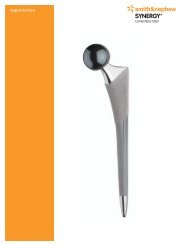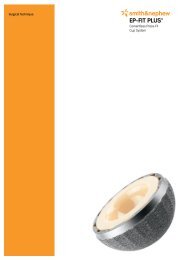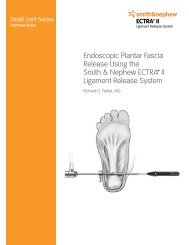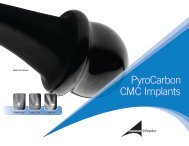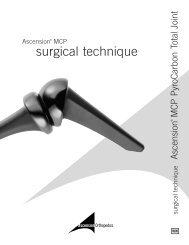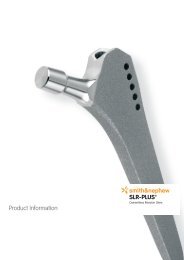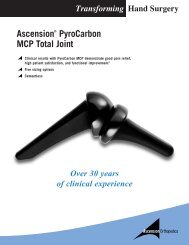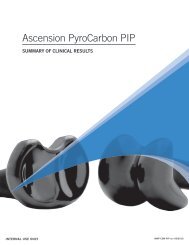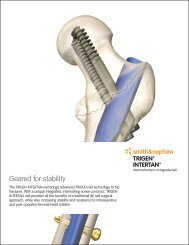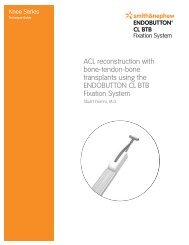1686-e_SL-PLUS MIA.indd
1686-e_SL-PLUS MIA.indd
1686-e_SL-PLUS MIA.indd
Create successful ePaper yourself
Turn your PDF publications into a flip-book with our unique Google optimized e-Paper software.
Discussion<br />
In this investigation a torsional moment was applied along the longitudinal axis of the stems for<br />
an isolated observation of rotational stability. This does not represent the actual physiological load<br />
situation but is well suited to allow an isolated evaluation of the impact of the design differences<br />
on the rotation stability and thus on the primary stability.<br />
Both stem models, <strong>SL</strong>-<strong>PLUS</strong> <strong>MIA</strong> Standard and <strong>SL</strong>-<strong>PLUS</strong> Standard, were identically and neutrally<br />
positioned in the FEM model. In both models the lateral cortical contact ends in the region of the<br />
trochanter, representing an average clinical situation.<br />
The virtually identical values for the ball head displacement taken as a measure of the maximum total<br />
deformation of the bone implant system show that, in terms of the displacement caused by rotation,<br />
the <strong>SL</strong>-<strong>PLUS</strong> <strong>MIA</strong> Standard stem is equivalent to the <strong>SL</strong>-<strong>PLUS</strong> Standard stem. The slightly lower displacement<br />
of the <strong>SL</strong>-<strong>PLUS</strong> <strong>MIA</strong> Standard stem compared with the <strong>SL</strong>-<strong>PLUS</strong> Standard stem (0.5%) can be<br />
attributed to the reduced weakening of the greater trochanter, leading to greater rigidity in this region.<br />
Both systems show a primarily distally based load transmission to the cortical bone. The stress represented<br />
as a measure of the anchoring forces is greater in the distal cortical bone than in the trochanter<br />
region. In the <strong>SL</strong>-<strong>PLUS</strong> Standard stem these forces fall steadily above the second-lowest cross hole.<br />
Further, in the proximal region the contact is primarily between the cancellous bone and the implant,<br />
where the forces are lower due to the mechanical properties of the bone. The lateral shoulder of the<br />
<strong>SL</strong>-<strong>PLUS</strong> Standard stem, which has been eliminated in the <strong>SL</strong>-<strong>PLUS</strong> <strong>MIA</strong> Standard stem in favor of<br />
an implantation technique that preserves more tissue, has a relatively low impact on the rotational stability,<br />
as it is mainly in the cancellous bone. This explains why, without the lateral shoulder of the<br />
<strong>SL</strong>-<strong>PLUS</strong> Standard stem, the <strong>SL</strong>-<strong>PLUS</strong> <strong>MIA</strong> Standard stem is very similar to the <strong>SL</strong>-<strong>PLUS</strong> Standard stem<br />
in terms of its rotational stability under application of a torsional moment.<br />
Finally, it should be noted that, as a result of the different implantation techniques, the greater trochanter<br />
is weakened to a greater extent with the <strong>SL</strong>-<strong>PLUS</strong> Standard stem than with the <strong>SL</strong>-<strong>PLUS</strong> <strong>MIA</strong> Standard<br />
stem. As the greater trochanter is not weakened to the same extent as with the implantation of the<br />
<strong>SL</strong>-<strong>PLUS</strong> Standard stem, this seems to compensate for the anticipated loss of rotational stability resulting<br />
from the design of the <strong>SL</strong>-<strong>PLUS</strong> <strong>MIA</strong> Standard stem. Both bone-implant systems show identical<br />
values for deflection during rotational loading on its own.<br />
06



